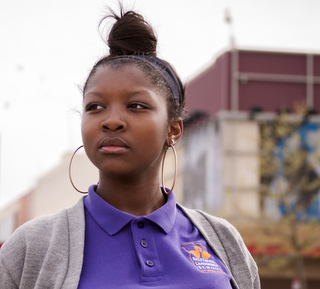The AFRO asked young people who were affected by the events of one year ago to talk about what they saw and how it made them feel.

Angel Burton, 17
Angel Burton, 17
“My principal made an announcement and said go straight home,” recalls 17-year-old Angel Burton, a high school senior in Baltimore, when asked what she remembers about the unrest April 27, 2015. “We had already heard about what was going on across the city through social media, but then I went home and saw that it was really serious. I didn’t think that people would really participate in a riot. I didn’t know it would go that far.”

Devaun Williams, 16
Devaun Williams, 16
“It was chaos,” said 16-year-old Devaun Williams, recalling the scene when he arrived to at the Mondawmin Mall transit hub on April 27, 2015. “My adrenaline was pumping I just wanted to see what was going on. The people started arguing with the police but they weren’t trying to hear it. Then there was a lot of smoke and police and everything was happening so fast.”
When asked what has changed in the year since the riots, Williams said “Police are still doing the same thing. They don’t get punished the way we get punished for doing the same stuff. I would have had life in prison,” he said, considering the circumstances of Freddie Gray’s death on April 19th, 2015. “I just want the police to be fair. We still have follow the laws and the rules, but if they do police do their part, we’ll out part.”

Christopher Hawkins, 16
Christopher Hawkins, 16
“I have five brothers and two sisters,” said Hawkins, who said he doesn’t see Baltimore changing much. “It’s too much going on in the city and I don’t want to end up dead like everyone else,” he said. When asked about police brutality, Hawkins said that he is tired of the harassment. “I was leaving school one day and the officer followed me. He asked where I was going. I said ‘It’s 3 o’clock in the afternoon. I just left school.’ He wanted to know if I left school early.”
Chris Carroll, 17
“I didn’t hear the name ‘Freddie Gray’ until two days after he had died. At first it was nothing new. It wasn’t something I didn’t expect to happen- I knew it could happen because we had others,” said Chris Carroll, 17, who watched the riots unfold from his 18th story window on Calvert Street. “We were watching buildings burn on the news and watching it from the window. It was actually happening. There were six helicopters in the sky. We didn’t know it would be that bad. We heard it was coming but when it happened it was a whole different level.”

Tijay Hart-Alderman, 14
Tijay Hart-Alderman, 14
“On April 27, 2015 I was in school,” said Tijay Hart-Alerderman, a 14-year-old student. “They were telling us what was happening- that traffic was being stopped and people were jumping on top of cars. I wanted to leave Baltimore.”

Paul Bridgeford, 18
Paul Bridgeford, 18
For many Baltimore youth, word of the unrest came in waves of via social media status updates, shared articles, and pictures. “On April 27th I was home watching TV when I started seeing social media posts about Baltimore. I turned on the news and saw what was happening to my city and I was immediately afraid,” Paul Bridgeford, who was a high school senior at the time, told the AFRO. “When I got a clear picture of what was going on I started feeling a lot of different emotions. I felt shame, I felt anger, I felt pity, but I also felt relief. I felt relief because a small part of me was resting on ‘it’s about time we fought back.’ The relief was soon buried in my need to help heal the situation in any way I could. So I got to work.”
Feeling the need to make change in the streets of Baltimore, Paul Bridgeford joined the Street Engagement Unit of the 300 Men March Movement, taking Baltimore back block by block. “Being a part of the 300 Men March shows kids that they don’t have to be drug dealers. It’s iconic for the younger boys because they can still become the man they see on the street, but in a positive manner.”
“I don’t feel like Baltimore County is any safer for a black boy,” said Bridgeford’s mother, Erricka Bridgeford, the director of training for Community Mediation Maryland. “I’m worried about him when he’s just driving right around here. That time just brought all of the feelings you know exist. When you see police officers on the street with rifles as tall as you- you are very aware of who is the target.”


